
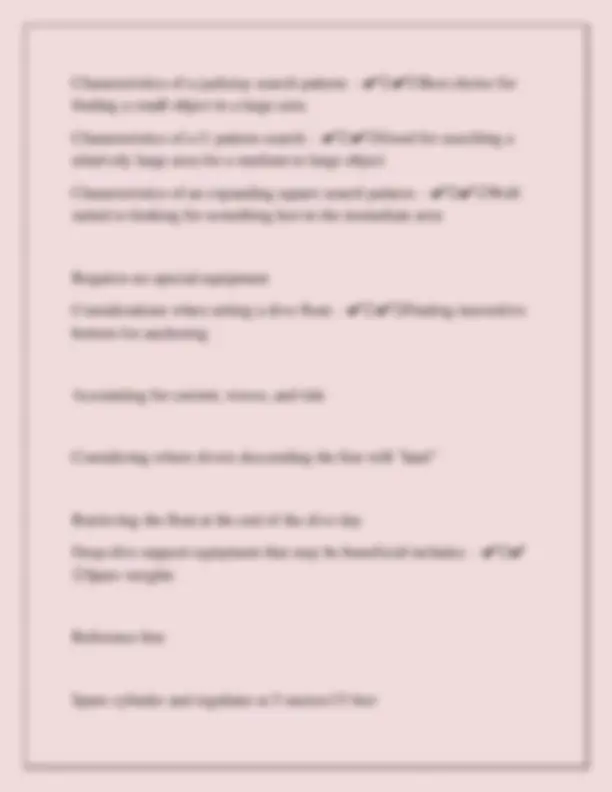
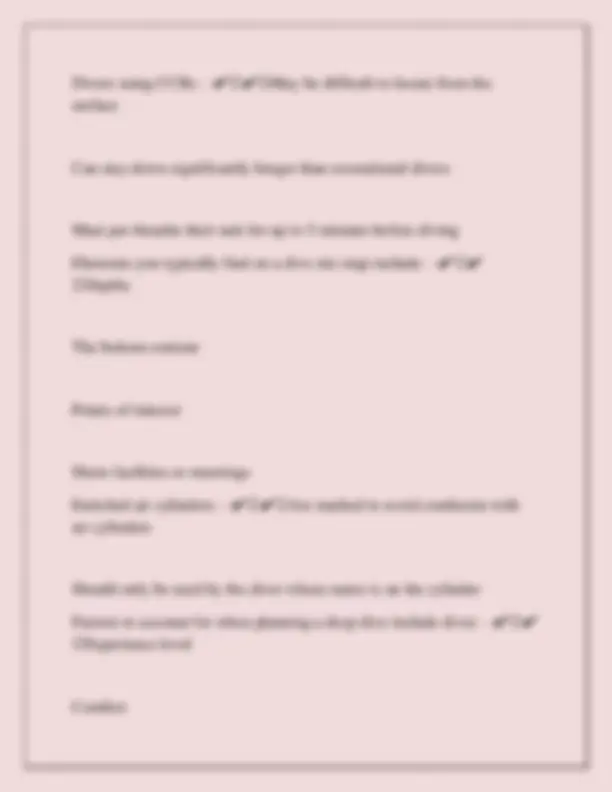
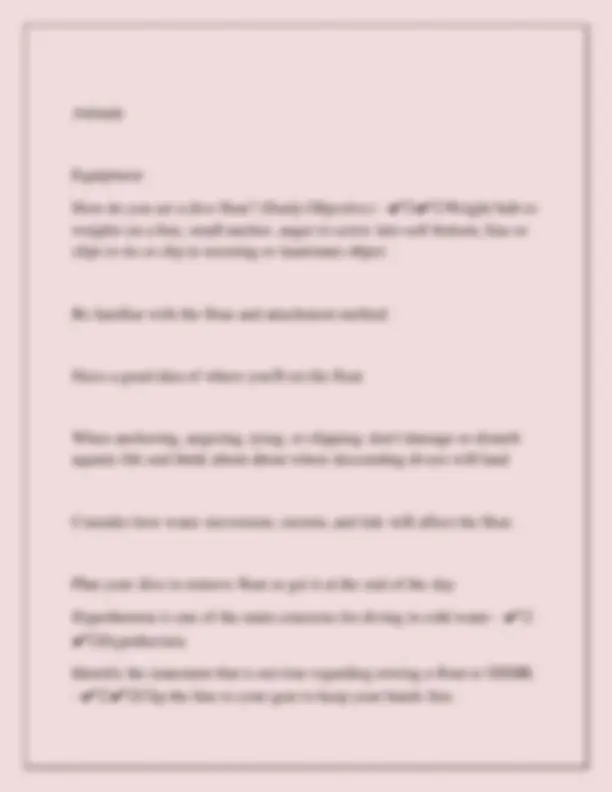
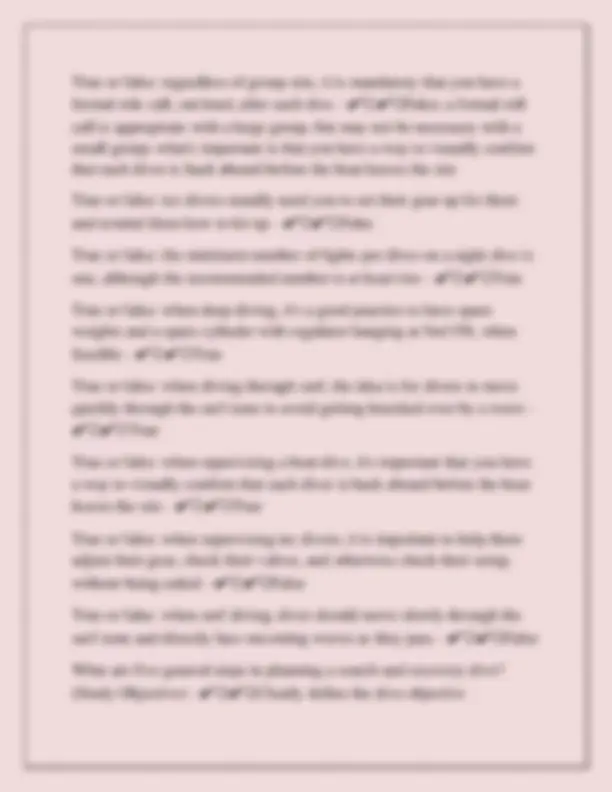
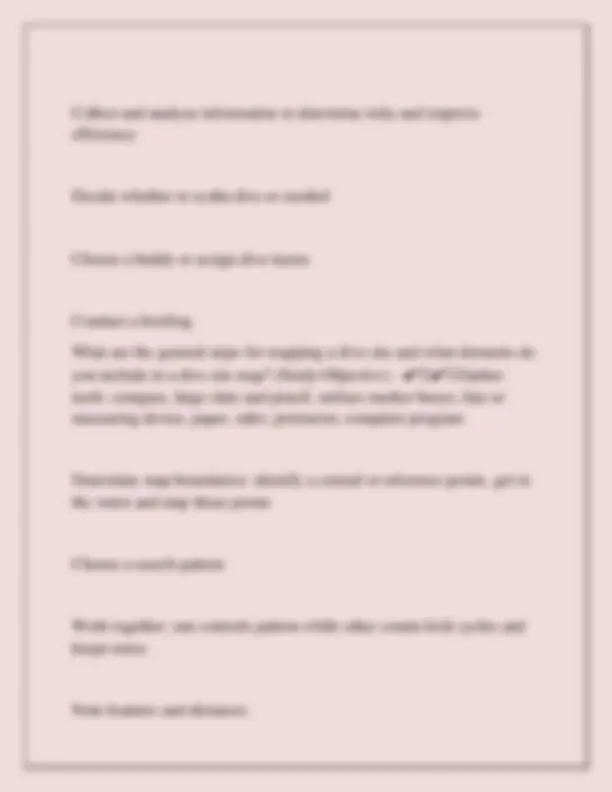
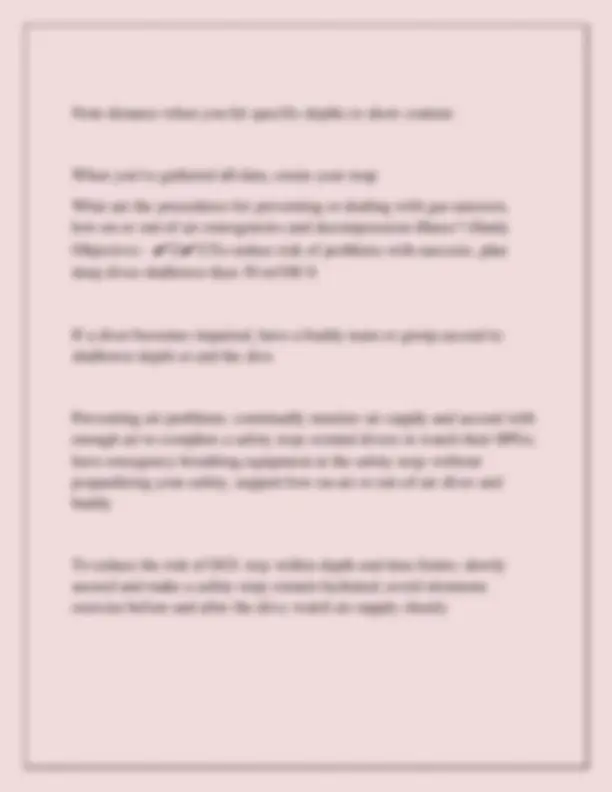
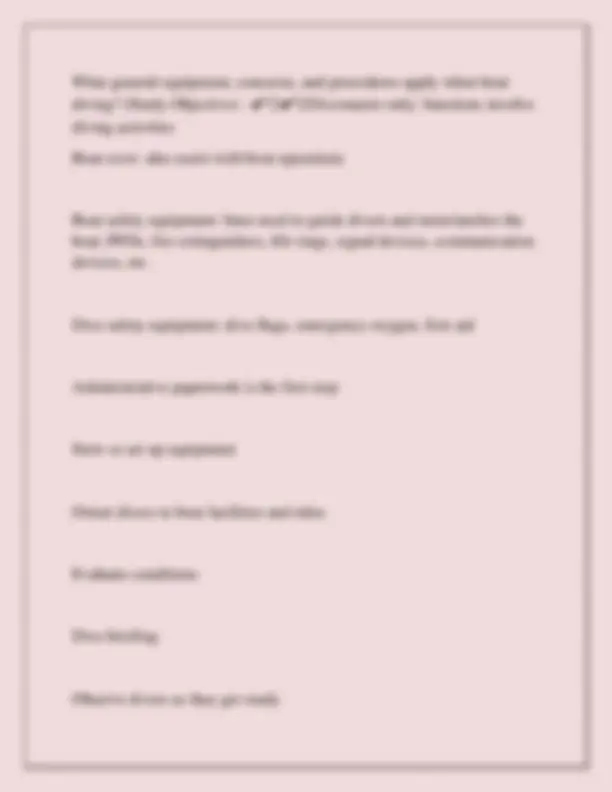
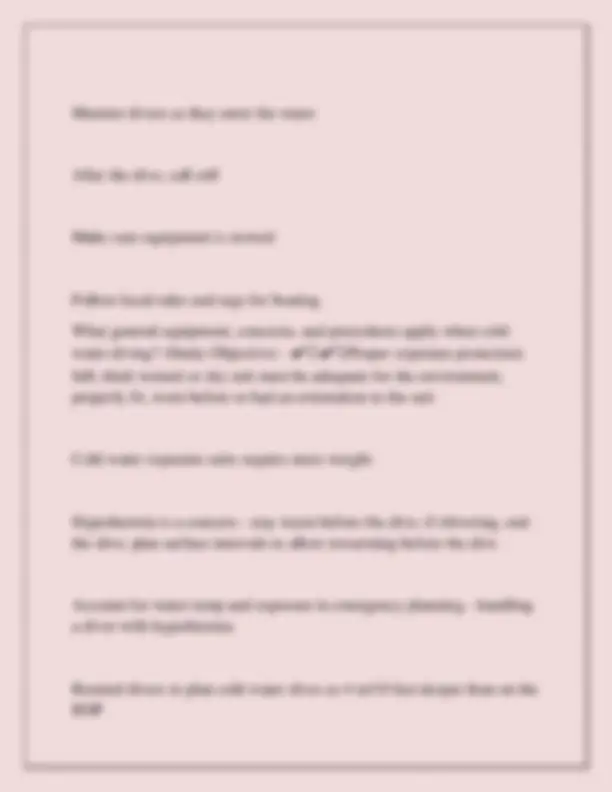
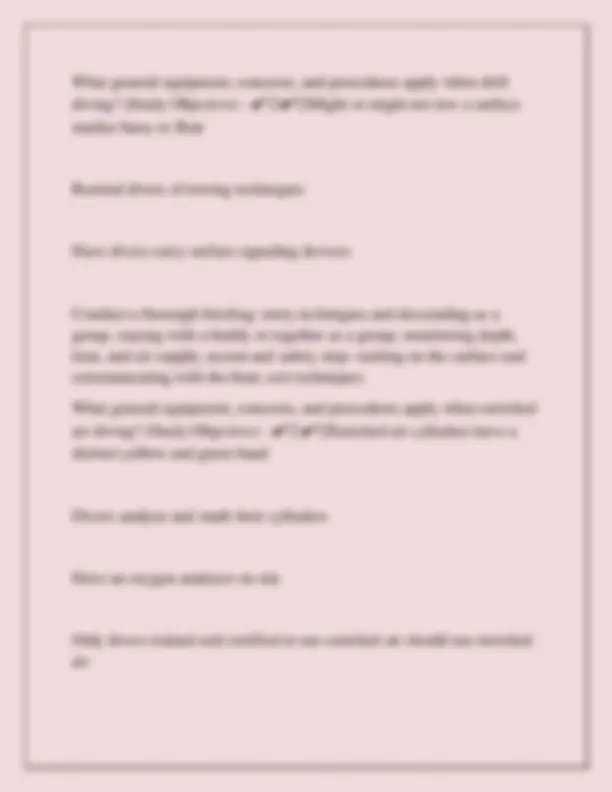
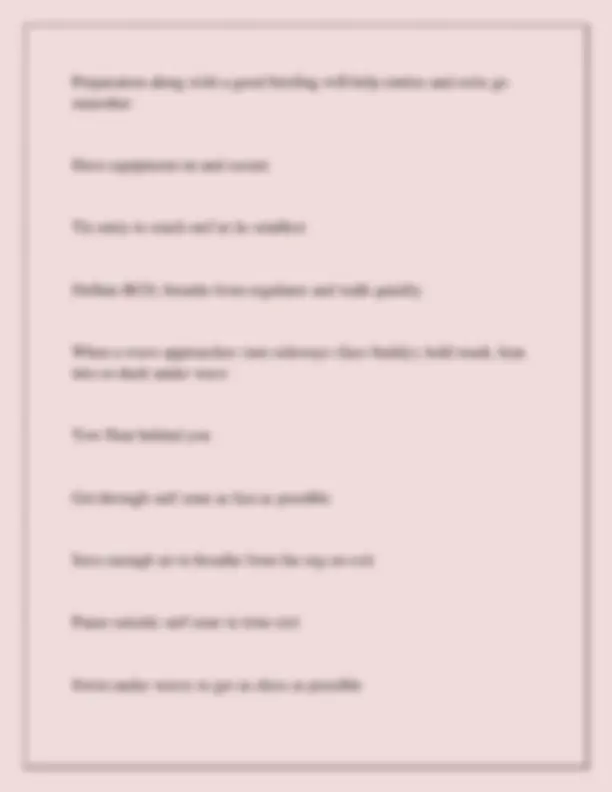
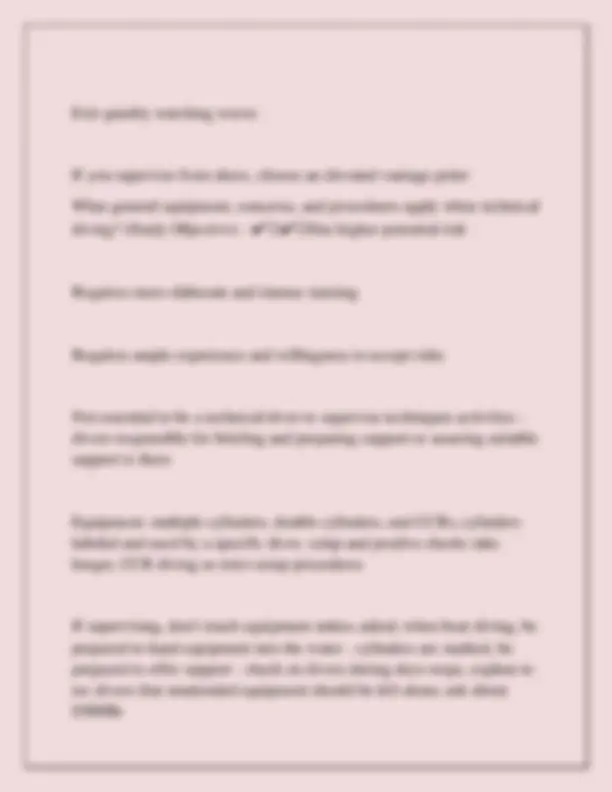
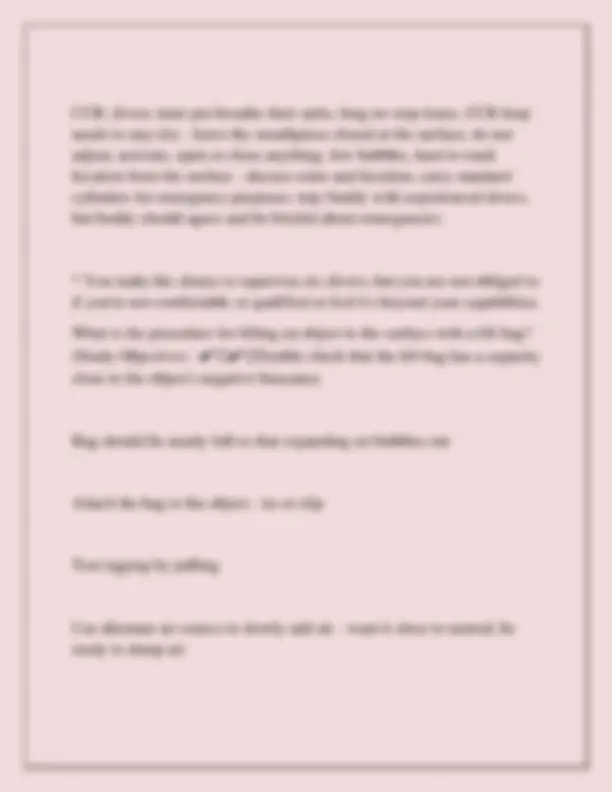
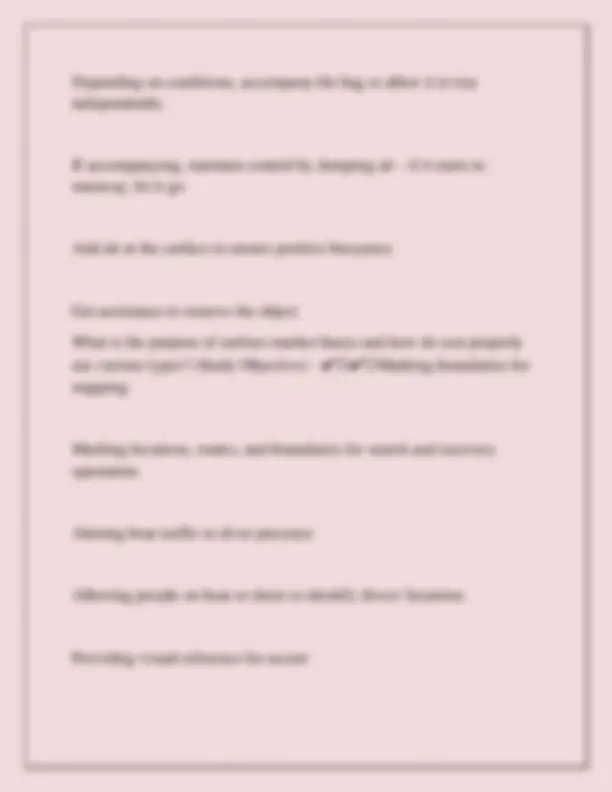
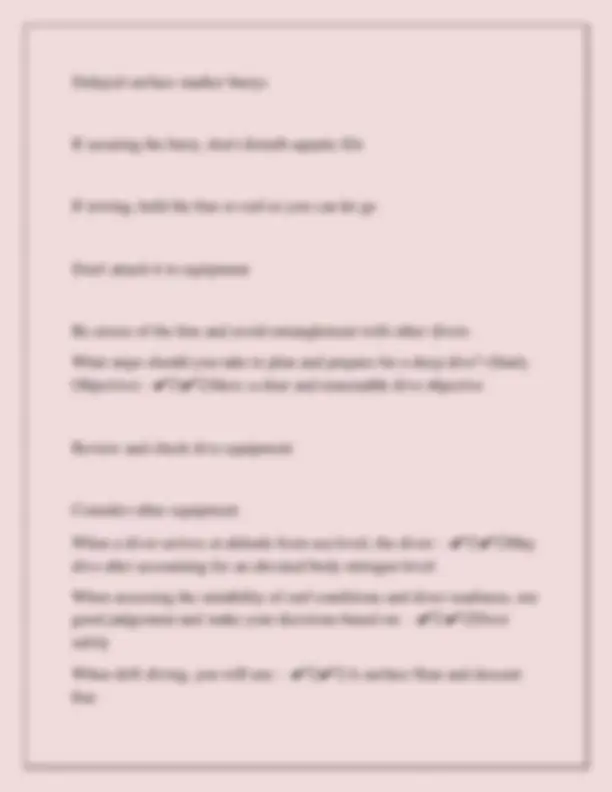
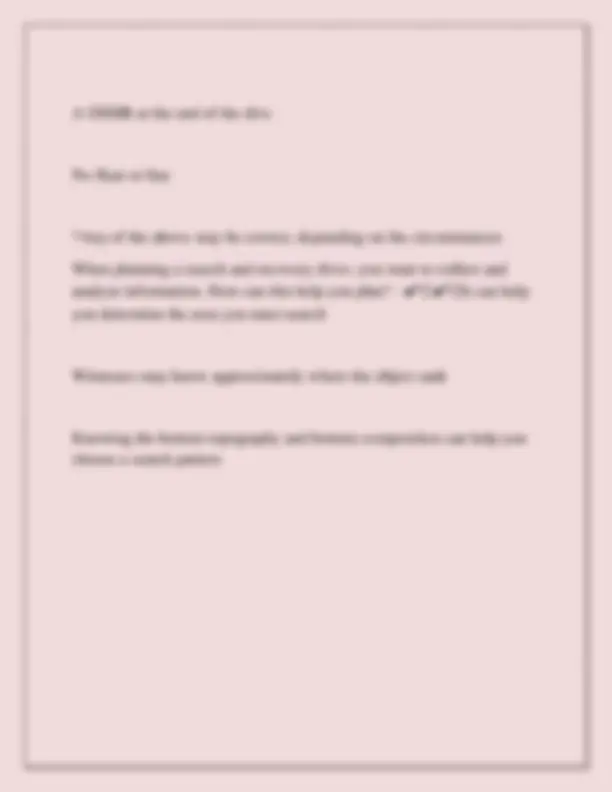


Study with the several resources on Docsity

Earn points by helping other students or get them with a premium plan


Prepare for your exams
Study with the several resources on Docsity

Earn points to download
Earn points by helping other students or get them with a premium plan
Community
Ask the community for help and clear up your study doubts
Discover the best universities in your country according to Docsity users
Free resources
Download our free guides on studying techniques, anxiety management strategies, and thesis advice from Docsity tutors
A collection of 66 questions related to padi divemaster specialized skills and activities. It covers various aspects of divemaster responsibilities, including search and recovery techniques, dive site mapping, deep dive procedures, and safety protocols. The questions are designed to test knowledge and understanding of essential divemaster skills and practices.
Typology: Exams
1 / 23

This page cannot be seen from the preview
Don't miss anything!
















When using your alternate air source, or accessory inflator, to add air toa lift bag, you should: - ✔ ✔ Add air slowly and fill the lift bag with enough air so that it's close to neutral Which of the following patterns would generally be the preferred patternfor mapping? - ✔ ✔ U-pattern You and your buddy are planning to map a dive site that is 100m/330ftby 100m/330ft. You need a useable map that has reasonable accuracy, but the map will be used for dive briefings, not archaeology or anythingscientific. What measurement method would be appropriate? - ✔ ✔ Kick cycles You have to anchor a float that will be used by OWD students on theirfirst dive. You find a very small sand patch right next to a beautiful coral stand. Which statement most likely represents what you would do? - ✔ You would look for a better place to anchor the float. ✔ You're ascending with a lift bag and it starts to runaway from you. Youshould _______ - ✔ ✔ Let it go
______ is usually the biggest concern unique to night diving - Light failure ✔ ✔ A team of recreational divers wants you to supervise a dive to 24m/80ftto map a wreck's wheelhouse, photograph the telegraph, locate a moray eel known to live there, and photograph the eel. Which of the following
would probably be the most appropriate response? -tell the divers they need to pick one or at most two, of those objectives ✔ ✔ Agree, but As a divemaster, what signaling and safety devices should you carry andknow how to use? Study Objective) - ✔ ✔ Two surface signaling devices: one audible and one visual Whistle or air horn Signal mirror, surface marker buoy, inflatable signal tube, emergencystrobe Before departure when supervising a boat dive, you usually want to: - ✔ Confirm everyone's aboard and listed on the roster ✔
Have everyone complete documents (liability releases, etc.) Make sure equipment is properly stowed Let divers know how long it will take to get to the dive site Characteristics of a circular or semicircular search pattern: - Difficult to apply over an obstructed bottom ✔ ✔
Requires a line and reel
Divers using CCRs: -surface ✔ ✔ May be difficult to locate from the
Can stay down significantly longer than recreational divers Must pre-breathe their unit for up to 5 minutes before diving Elements you typically find on a dive site map include: - Depths ✔ ✔
The bottom contour Points of interest Shore facilities or moorings Enriched air cylinders: -air cylinders ✔ ✔ Are marked to avoid confusion with
Should only be used by the diver whose name is on the cylinder Factors to account for when planning a deep dive include diver: - Experience level ✔ ✔
Comfort
Attitude Equipment How do you set a dive float? (Study Objective) -weights on a line, small anchor, auger to screw into soft bottom, line or ✔ ✔ Weight belt or clips to tie or clip to mooring or inanimate object Be familiar with the float and attachment method Have a good idea of where you'll set the float When anchoring, angering, tying, or clipping: don't damage or disturbaquatic life and think about about where descending divers will land
Consider how water movement, current, and tide will affect the float Plan your dive to remove float or get it at the end of the day Hypothermia is one of the main concerns for diving in cold water - ✔ Hypothermia ✔ Identify the statement that is not true regarding towing a float or DSMB.- ✔ ✔ Clip the line to your gear to keep your hands free.
Compass Large slate and pencil Surface marker buoys True or false: a primary concern regarding low-on-air and out-of-airsituations on a deep dive is that divers use gas faster at deeper depths - ✔ ✔ True True or false: a surface marker buoy may be used to mark the location ofa buddy team or group - ✔ ✔ True True or false: altitude diving procedures account for the fact that mostdecompression models used in dive tables and dive computers were developed for sea level use - ✔ ✔ True True or false: do not touch a technical diver's gear unless asked to do soby the diver - ✔ ✔ True True or false: during a drift dive, its a good idea to have each diver carrya surface signal device - ✔ ✔ True True or false: it is acceptable for EANx divers to use any EANx cylinderavailable - ✔ ✔ False True or false: one of the concerns in supervising enriched air nitro is thatonly certified EANx divers should use enriched air - ✔ ✔ True or false: proper exposure protection for diving in cold water alwaysmeans wearing a dry suit - ✔ ✔ False
True or false: regardless of group size, it is mandatory that you have aformal role call, out loud, after each dive - ✔ ✔ False; a formal roll call is appropriate with a large group, but may not be necessary with asmall group; what's important is that you have a way to visually confirm that each diver is back aboard before the boat leaves the site True or false: tec divers usually need you to set their gear up for themand remind them how to kit up - ✔ ✔ False True or false: the minimum number of lights per diver on a night dive isone, although the recommended number is at least two - ✔ ✔ True True or false: when deep diving, it's a good practice to have spareweights and a spare cylinder with regulator hanging at 5m/15ft, when feasible - ✔ ✔ True True or false: when diving through surf, the idea is for divers to movequickly through the surf zone to avoid getting knocked over by a wave - ✔ ✔ True True or false: when supervising a boat dive, it's important that you havea way to visually confirm that each diver is back aboard before the boat leaves the site - ✔ ✔ True True or false: when supervising tec divers, it is important to help themadjust their gear, check their valves, and otherwise check their setup, without being asked - ✔ ✔ False True or false: when surf diving, diver should move slowly through thesurf zone and directly face oncoming waves as they pass - ✔ ✔ False What are five general steps in planning a search and recovery dive?(Study Objective) - ✔ ✔ Clearly define the dive objective
Note distance when you hit specific depths to show contour When you've gathered all data, create your map What are the procedures for preventing or dealing with gas narcosis,low-on or out-of-air emergencies and decompression illness? (Study Objective) -deep dives shallower than 30 m/100 ft ✔ ✔ To reduce risk of problems with narcosis, plan
If a diver becomes impaired, have a buddy team or group ascend toshallower depth or end the dive
Preventing air problems: continually monitor air supply and ascend withenough air to complete a safety stop; remind divers to watch their SPGs; have emergency breathing equipment at the safety stop; withoutjeopardizing your safety, support low-on-air or out-of-air diver and buddy To reduce the risk of DCI: stay within depth and time limits; slowlyascend and make a safety stop; remain hydrated; avoid strenuous exercise before and after the dive; watch air supply closely
If you suspect DCI: primary assessment, contact emergency care, havethe diver lie down, give emergency oxygen, manage shock, arrange emergency evacuation and medical care What factors should you take into account when supervising a deepdive? (Study Objective) - ✔ ✔ How experienced the divers are
Remind divers to make contingency plans for accidentally exceedingdepth and time
Potential for going deeper than planned Diver comfort, skill, and attitude What general considerations should you take into account when usingsearch patterns? (Study Objective) - ✔ ✔ Goal: cover the search area as quickly and efficiently as possible without leaving gaps Pick the best pattern based on search are, topography, divers, andequipment
Begin at a specific location Use the simplest pattern that will work
What general equipment, concerns, and procedures apply when boatdiving? (Study Objective) - ✔ ✔ Divemaster only: functions involve diving activities Boat crew: also assist with boat operations Boat safety equipment: lines used to guide divers and moor/anchor theboat; PFDs, fire extinguishers, life rings, signal devices, communication devices, etc. Dive safety equipment: dive flags, emergency oxygen, first aid Administrative paperwork is the first step Stow or set up equipment Orient divers to boat facilities and rules Evaluate conditions Dive briefing Observe divers as they get ready
Monitor divers as they enter the water After the dive, call roll Make sure equipment is stowed Follow local rules and regs for boating What general equipment, concerns, and procedures apply when coldwater diving? (Study Objective) - ✔ ✔ Proper exposure protection: full, thick wetsuit or dry suit must be adequate for the environment,properly fit, worn before or had an orientation to the suit
Cold water exposure suits require more weight Hypothermia is a concern - stay warm before the dive; if shivering, endthe dive; plan surface intervals to allow rewarming before the dive
Account for water temp and exposure in emergency planning - handlinga diver with hypothermia
Remind divers to plan cold water dives as 4 m/10 feet deeper than on theRDP
Divers use their marked cylinder and are responsible for gas content -watch that divers don't take the wrong cylinder
Divers plan dives with dive computers or using their RDP, the EnrichedAir RDPs, the Equivalent Air Depth Table and Oxygen Exposure Table
Encourage divers to stay well within accepted oxygen limits Remind divers to properly set dive computers before getting in the water What general equipment, concerns, and procedures apply when nightdiving? (Study Objective) - ✔ ✔ Prep starts with equipment, especially lights: surface lights for before and after the dive, markerlights to identify exit point, each diver has a light, have spares, chemical or personal marker lights Full exposure protection Audible surface signaling device Underwater markers Assess factors - diver experience, comfort, environmental conditions
Determine best place to supervise Have someone on the shore or boat to tend marker lights, help withequipment, and provide assistance
Briefing reminders: don't shine lights in the eyes of other divers; checkdepth, time, direction, air, and buddy's position frequently; keep nav simple and slow; maintain good buoyancy; if light fails, go to backupand end dive or end using buddy's light to surface What general equipment, concerns, and procedures apply when shorediving when divers must enter through surf? (Study Objective) - ✔ ✔
are acceptable^ Be familiar with local sites to decide when surf height and conditions Watch the wave pattern long enough to determine how high the largestsurf is
Consider abilities of divers Use good judgement based on diver safety Potential for equipment loss or damage
Exit quickly watching waves If you supervise from shore, choose an elevated vantage point What general equipment, concerns, and procedures apply when technicaldiving? (Study Objective) - ✔ ✔ Has higher potential risk
Requires more elaborate and intense training Requires ample experience and willingness to accept risks Not essential to be a technical diver to supervise techniques activities -divers responsible for briefing and preparing support or assuring suitable support is there Equipment: multiple cylinders, double cylinders, and CCRs; cylinderslabeled and used by a specific diver, setup and predive checks take longer, CCR diving as strict setup procedures If supervising, don't touch equipment unless asked; when boat diving, beprepared to hand equipment into the water - cylinders are marked, be prepared to offer support - check on divers during deco stops, explain torec divers that unattended equipment should be left alone; ask about DSMBs
CCR: divers must pre-breathe their units, long no stop times, CCR loopneeds to stay dry - leave the mouthpiece closed at the surface; do not adjust, activate, open or close anything; few bubbles, hard to tracklocation from the surface - discuss route and location; carry standard cylinders for emergency purposes; may buddy with experienced divers,but buddy should agree and be briefed about emergencies